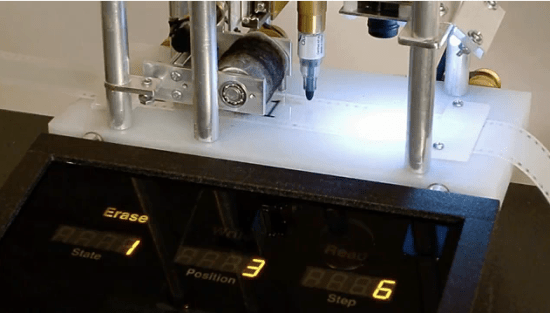DIY Turing Machine in Action [Video]
Turing machines don’t even need physical mechanisms, despite their having the word “machine” in their names — indeed, they’re one of the textbook examples that functionalist philosophers use to present their theory of mind as a series of inputs and outputs. At that, Turing machines, as Alan Turing proposed them in 1936, have quite a bit in common with modern computers, whose elegant, thought-experiment cousins they might be considered to be:
In non-technical terms, a Turing machine can be visualized as an indefinitely and infinitely long tape divided into rectangles (the memory) with a box-shaped scanning device that sits over and scans one component of the memory at a time. Each unit is either blank (B) or has a 1 written on it. These are the inputs to the machine. The possible outputs are:
- Halt: do nothing.
- R: move one square to the right.
- L: move one square to the left.
- B: erase whatever is on the square.
- 1: erase whatever is on the square and print a ‘1.
Remarkably, Mike Davey recently made theory into reality when he built a working Turing machine using a felt-tip pen, a Parallax propeller, motors, and 1000 feet of white film leader. Video after the jump:
From Davey’s project description: [do read the whole thing, and check out his other projects.]
My goal in building this project was to create a machine that embodied the classic look and feel of the machine presented in Turing’s paper. I wanted to build a machine that would be immediately recognizable as a Turing machine to someone familiar with Turing’s work.
Although this Turing machine is controlled by a Parallax Propeller microcontroller, its operation while running is based only on a set of state transformations loaded from an SD card and what is written to and read from the tape. While it may seem as if the tape is merely the input and output of the machine, it is not! Nor is the tape just the memory of the machine. In a way the tape is the computer. As the symbols on the tape are manipulated by simple rules, the computing happens. The output is really more of an artifact of the machine using the tape as the computer.
The heart of the turing machine is the read-write head. The read-write head transports the tape and positions cells of the tape appropriately. It can read a cell determining what, if any, symbol is written there. The machine works on, and knows about, only one cell at a time. The tape in my machine is a 1000’ roll of white 35mm film leader. The characters, ones and zeros, are written by the machine with a black dry erase marker.
And here’s the Turing machine in action:
(via Neatorama)
Have a tip we should know? tips@themarysue.com
